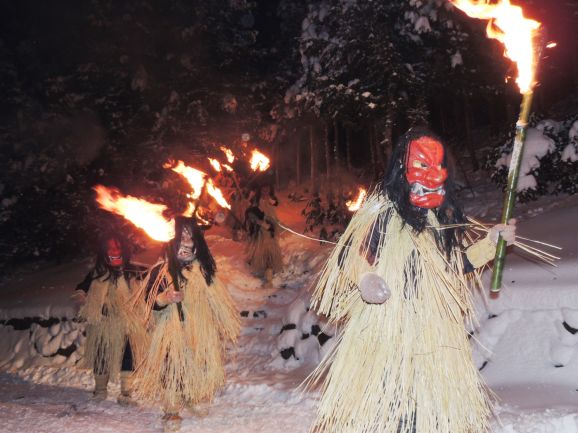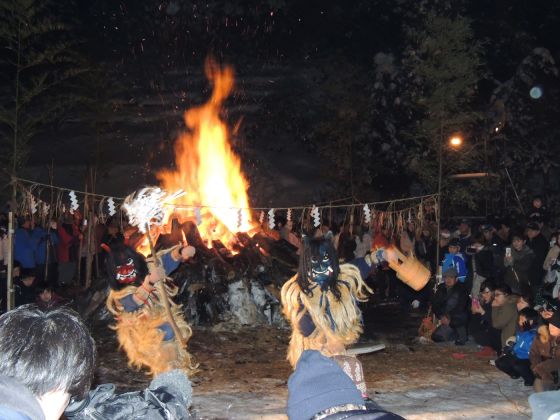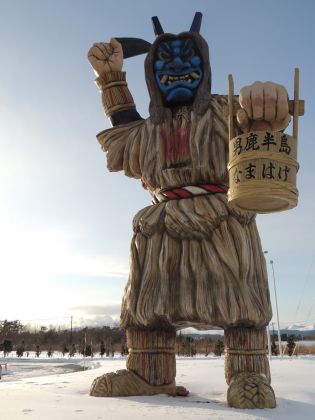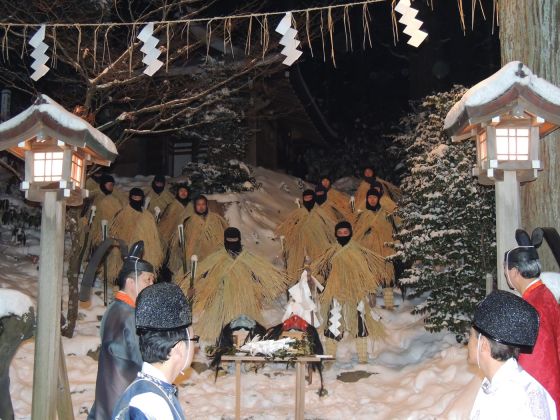
The 'namahage' demons of Akita Prefecture descend from the mountains to check everyone is behaving properly. (Photos by Nathan Hill)
Japan Today carries a report of an interesting midwinter festival in northern Japan. Fifteen “namahage” bearing torches of fire come down a mountain on Sunday night at the 51st Namahage Sedo Festival. Held over three nights every February in Oga City, Akita Prefecture, it is one of the five major festivals of the Tohoku winter. The “namahage” travel with a “naughty and nice” book in which is recorded information about the inhabitants of each house gathered in advance. Using this information the “namahage” will admonish children to behave better, study harder, wash behind their ears, or whatever it is that the child’s parents told the “namahage” earlier.
*************************************************************************************

Yuletide fires and demons of the night create a pagan atmosphere in the midwinter cold of northern Japan
A website dedicated to the ‘namahage’ operated by the Oga Board of Education states that the oldest record concerning them dates back to a travel writer in the mid-Edo period. There are various theories concerning their origin. One is to do with a legend about Emperor Wu coming to Oga. Another is that they represent Shugendo mountain ascetics (in similar manner to tengu). Another is that they are simply messengers of a mountain god which protects Oga. And yet another is that they may represent immigrants who arrived on the Oga coast and were ‘demonised’ because of their appearance.
On New Year’s Eve, young men of the various villages dressed as Namahage go from house to house shouting loudly “Are there any crybabies here? Any kids who don’t listen to their parents?” and “Does the woman of the house wake up early?” To the people of Oga, the Namahage are visiting gods that come with the New Year to warn against laziness, and bring protection from illness and disasters, a good harvest, and plentiful food from the mountains and sea. The houses that welcome the Namahage prepare traditional food and sake and offer it graciously to them.
Namahage events used to be held on the Lunar New Year in Oga, but now they are held on Dec.31. Due to a lack of participants to pass on the tradition, the number of areas holding Namahage events has been decreasing year by year. However they have recently been making a comeback. In 1978, Oga’s Namahage were designated officially as an Important Intangible Cultural Asset.
******************************************************************************************

Like Santa, the namahage descend once a year - but with a stern message instead of presents
Under the light of the Sedo fire at Shinzan Shrine, after the “Yunomai” dedication of Haraikagura sacred dance (unique to the Oga area), and “Chinkamasai”, an old Shinto traditional religious service using hot water in a pot, the Sedo Festival starts. Young men are presented with masks which have been purified by a Shinto priest, and become Namahage. They then go back to the mountain, and a ceremony called “Namahage nyukon” (Namahage-spirit-investment) is held.
On stage at the shrine’s Kakuraden, some performances are held, including a reproduction of the Namahages’ New Years’ visits, “Sato no Namahage”, in which Namahage appear in different masks and costumes, and Namahage Daiko (Japanese drumming) as folk art.
In front of the Sedo fire, Namahage dance music created by Baku Ishii (modern dancer) and his son, Kan Ishii (composer), is played dynamically.
At the end of the festival, it’s fantastic to see the Namahage with torches coming down from the snowy mountain. After coming down the mountain, the Namahage walk around the shrine among the many visitors, and the festival ends.
The Shinto priests dedicate Goma-mochi (rice cakes) which are roasted on the Sedo fire as an offering to the Namahage. Then the Namahage return to the deep mountain where the God is.
The Sedo Festival is the one of the principal winter festivals in the Tohoku area. Collectively they are called the Michinoku Big 5 Snow Festivals, and also include the Yokote Kamakura, Hirosaki Castle Lantern Festival, Hachinohe Emburi, and Iwate Snow Festival.

The namahage participants gather before the shrine where their ritually purified masks await them.

Namahage are sort of at the halfway point between Santa and Krampus, then.